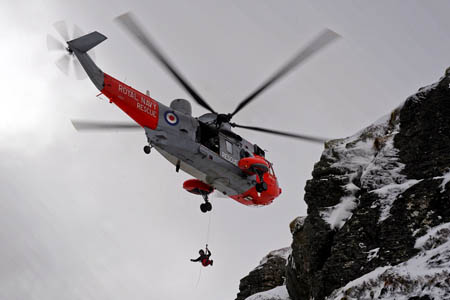Have you been fortunate – or perhaps unfortunate – to have been rescued by one of the Royal Navy’s search and rescue helicopters?
The service is celebrating its 60th anniversary and to mark the milestone, the Royal Navy is asking walkers, climbers and other outdoor enthusiasts who have been helped by one of its aircraft to come forward.
The service is interested in hearing details from anyone rescued by the Sea King, Wessex, Whirlwind or Dragonfly helicopters since it began operations in 1953.
It would also like to hear from former crew members who have stories to tell.
A Royal Navy spokesperson said: “These tales will help form the back bone of an on-going project to bring together all aspects of the service within a comprehensive archive, preserving the history for years to come.”
The red and grey Sea Kings from HMS Gannet in Ayrshire are a common sight in the Scottish Highlands, northern England and Northern Ireland as they help injured and stricken walkers and climbers.
Rescuers from HMS Gannet have been decorated with operational honours for their part in some notable rescues, including that of three climbers in a blizzard from Tower Ridge on Ben Nevis in 2007, a climber from an avalanche in Glencoe in 2009 and, most recently, a climber with an ankle injury from Argyll’s Beinn Sgulaird in 2011.
Three were carried out under cover of darkness and all were in horrendous weather.
HMS Gannet, as first 819 Naval Air Squadron and later Gannet SAR Flight have both used variations of the familiar Sea King, which is still operational but due to end service in 2016 when the search and rescue operations will be privatised.
HMS Gannet is the only unit to have operated search and rescue from two locations – HMS Gannet was previously based at RNAS Eglinton in Northern Ireland until the base closed in 1959.
The Royal Navy’s search and rescue aircraft have operated from 11 bases over the past six decade, eight of which are now closed.
HMS Seahawk at Culdrose in Cornwall has operated the full range of naval search and rescue helicopters – the Westland Dragonfly, Whirlwind, Wessex and Sea King – during a period from 1953 to the present day.
The base’s range extends up into Devon, throughout Cornwall, down to the Isles of Scilly and 200 nautical miles out to sea across the Western Approaches.
Crews from the unit have been involved across the West Country and far out to sea in some of the UK’s most difficult rescues, including the 1979 Fastnet Race disaster, the 1989 rescue of the crew of the MV Muree, the Boscastle Floods of 2004 and the grounding of MSC Napoli in 2007.
In all these cases, and many others besides, members of 771 Naval Air Squadron were decorated for their life-saving efforts.
Anyone with a story to tell about their rescue by the Royal Navy is asked to email the service, including their name and contact details, along with the location of the rescue.
Alternatively send your memories to RN SAR 60, 771 NAS, RNAS Culdrose, Helston, Cornwall, TR12 7RH.
Further details and a form are on the Royal Navy’s website.
